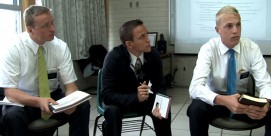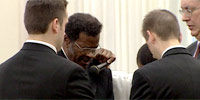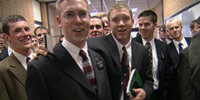LUCKY SEVERSON, correspondent: Off they go, two-by-two, in search of converts to the Church of Jesus Christ of Latter-day Saints—the Mormons. You know some of them. Presidential candidate Jon Huntsman was a missionary in Taiwan. Mitt Romney served a mission in France. Since the time of its first modern-day prophet Joseph Smith about 180 years ago, Mormons have sent over a million missionaries throughout the world.
STEVEN ALLEN: It is an international church.
SEVERSON: In fact, you have more members outside of the country than inside?
ALLEN: Si.
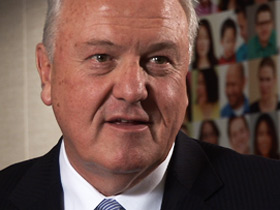
SEVERSON: Steve Allen is the managing director of the church’s missionary department, which has seen a huge increase in the number of missionaries in just over a year.
ALLEN: We had 58, 500 missionaries in October of 2012. We’ve shot up to over 80,000, almost 82,000 today serving.
SEVERSON: There’s a reason for this growth spurt of Mormon missionaries. The church’s president and current prophet, Thomas S. Monson, announced last year that young men would now be eligible to go on missions when they are 18 instead of 19, and young women could serve when they turn 19 instead of 21.
ALLEN: God is hastening his work. He’s speeding it up. We have a sense that there’s an urgency about spreading the message of the gospel across the world. I think it would be very safe to say that this was inspired from heaven.
SEVERSON: The number of baptisms per missionary has declined in recent years. Allen says it’s because of two factors. One is that missionaries spend more time to make sure new converts stay converted. The other is:
ALLEN: I know that the world’s becoming a tougher and tougher place and that the level of what we would refer to as wickedness is growing tremendously.
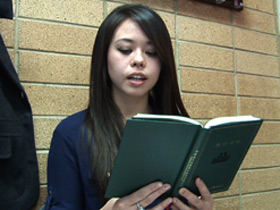
SEVERSON: This is the church’s main missionary training center in Provo, Utah. There are 14 other training schools throughout the world teaching 55 different languages. This is a class in mandarin. The female missionaries are referred to as Sister. After spending 9 weeks learning Mandarin, Sister Rolhfing is going to Taiwan.
SISTER ROLHFING: I’ve always planned to go on a mission since I was a little girl, so with the age change it just really made it more convenient to get to go a year earlier.
SEVERSON: Women in the church are not allowed to hold the priesthood. The young men are. They’re given the rank of Elder, which becomes their first name throughout the mission. Elder Russell is going to Canada.
(to Elder Russell): Why are you learning Mandarin if you’re going to Canada?
ELDER RUSSELL: I guess there’s a sizable population up there. I mean, everyone deserves to hear our message, so we’ll go worldwide wherever they are.
SEVERSON: This group is leaving soon for Ukraine. First, they had to be considered worthy of serving a mission.
LDS MISSIONARY: We submit our papers, which is just a kind of resume, and then the brethren, the quorum of the 12, they sit down and they pray about it and they look at our picture, and they decide through inspiration where we should serve our mission.
ALLEN: Missions are all about self-discipline. There’s an enormous amount of self-discipline out there. No TV, no Internet per se. They call home twice a year on Mother’s Day and Christmas Day. They communicate by email with their families once a week, and they work hard. It is hard, hard work—12-hour, 14-hour days.
SEVERSON: In this small community in Mexico you’ll find Elder Lopez from Pahrump, Nevada, a convert, and Elder French from Utah walking about 15 miles each day spreading the Gospel to anyone who will listen. Each and every morning, for up to four hours they’re studying the Gospel. Families from the U.S. are asked to pay $400 a month. These two worked to help pay for their missions.
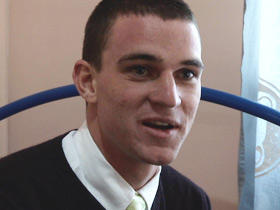
ELDER FRENCH: We always have to wake up at 6:30, we have like four alarms just to make sure—
SEVERSON: No sleeping in?
ELDER FRENCH: No sleeping in. If our companion tries to sleep in, we pour cold water on him.
SEVERSON: Seriously?
ELDER FRENCH: That’s what I'd do.
CARL PRATT: The week before they show up here they’re going around in flip-flops and gym shorts and t shirts. And here they’re all in white shirts and ties.
SEVERSON: Carl Pratt is president of the church’s missionary training center in Mexico City. In his professional life he’s a lawyer. The language school here is extensive and can handle up to 1200 students. Outside the campus is a world alien to many young missionaries. Cultures in this part of the world are steeped in Catholic tradition. Elder Alex Fortie from South Weber, Utah will be serving in Little Rock, Arkansas on a Spanish-speaking mission. [Editor's note: The name and hometown of this person were corrected in the transcript after the story aired.]
(speaking to Elder Fortie): Is this something you always wanted to do?
ELDER FORTIE: Nope. It’s not.
SEVERSON: So why are you here?
ELDER FORTIE: Because the idea of having an empty seat in heaven troubles me.
SEVERSON: Sister Waymith is from Sweet, Idaho.
SISTER WAYMITH: I decided to come on a mission because if it wasn’t for missionaries I probably wouldn’t be here, because my dad is a convert.
SEVERSON: Sister Brunsdale is fresh out of high school.
SISTER BRUNSDALE: Last year, right after the announcement I was like oh no, that means I can go, and then I was like oh wait, that means I can go, and I got super excited, and I got an answer from God that this is what I’m supposed to do.
SEVERSON: Sister Brunsdale is among many here learning Spanish only to go back to the U.S. to proselytize Latino residents. The church is devoting a good deal of attention to Spanish-speaking populations, even when they’re in pockets in the U.S.
(speaking to Steve Allen): Are there any countries in particular that you’re really zeroing in on, you’d really like to make some inroads?
ALLEN: Yeah, the United States of America, North America. We’d like to make more inroads here.
SEVERSON: Inroads like the church has made south of the border. Mexico, in particular, has been fertile ground for Mormon missionaries.
PRATT: We went from 50,000 members in 1963 to 1.3 million now.
SEVERSON: Although the fundamental message of the Mormon Church has changed little over the years, what has changed is the packaging. Not that many years ago, prospective converts heard more about Joseph Smith and the Book of Mormon. Today it’s first and foremost about Jesus Christ, which is an easier sell to other Christians, like all the Catholics here in Mexico.
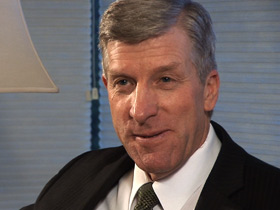
DANA CALL: The Mexican people are very warm, very receptive.
SEVERSON: Dana Call, a farmer by trade, is president of the Mexico City North mission. He’s in charge of 146 missionaries, like Sister Martinez, a third-year medical student from the Dominican Republic, and Sister Sandoval from Mexico, who was studying to be a civil engineer. She says her mom was afraid when she heard she was going to the dangerous big city, but sometimes it seems to her that people are more afraid of her.
SISTER SANDOVAL (speaking through translator): Some people, when they see us they run to the other side of the road. Others want to know more.
SEVERSON: On this day they’re visiting a member who needs help cleaning her house, also part of their calling. On their way here they knocked on some doors, something that is not that common anymore.
PRATT: Well, no, we don’t talk about door-to-door, although missionaries are certainly free to do that, but we talk about contacting on the streets, and we talk about mostly working through the members. That the members would invite their friends to visit with the missionaries.
SEVERSON: It was a member that referred Elders Lopez and French to this meeting with a potential convert.
ELDER FRENCH: We talk to members. We ask people—if we’re going to the store to buy something we ask the clerk at the store, we ask the person working there, who do you know that needs help in their life in this moment? Who do you know that could benefit from having a little more of Jesus Christ our Savior in their lives? And they tell us.
SEVERSON: The Mormons, like many churches, have seen active members stray from their congregations. Shoring up the wayward is now part of a missionary’s job.
CALL: President Monson calls it “the rescue”: go and get and find those who have strayed and bring them back.
SEVERSON: Since 1970, the Church of Jesus Christ of Latter-day Saints has grown from three million to over 15 million members worldwide, and these young men are determined to add to that number.





